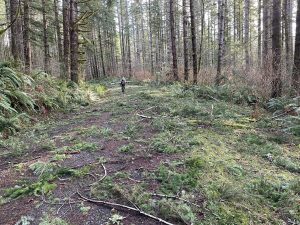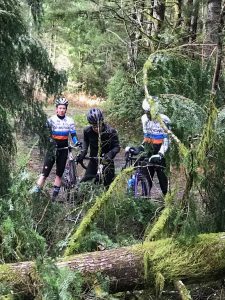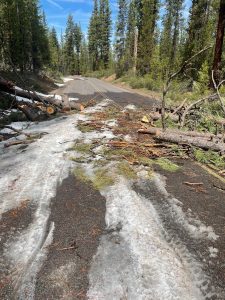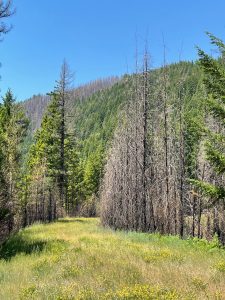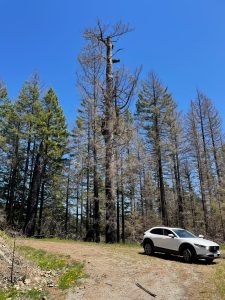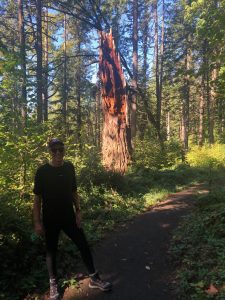Many folks have been unable to comment in the last few days. We had a security problem and so got more secure.. in fact too secure, so people have been unable to comment or post. Right now our web gurus are on it. I’ll let you know when it’s fixed.
Uncategorized
Climate Scenarios in Forest Plans
This essay by Roger Pielke Jr. offers an unusual and welcome take on Climate: “Is the World Ready for Good News on Climate?” Subhead:
“A new assessment of plausible futures suggests reasons for considerable optimism on climate policy.” Optimism on the climate? That’s virtually unheard of in the media.
Part of the subtext is that much of the scientific literature on climate change continues to base projections on implausible models, RCP 8.5 and its newer version, SSP5-8.5. Pielke and two coauthors of a paper on the topic in Environmental Research Letters (open access) suggest that the use of the more plausible scenarios “suggests that the world thus sits in an enviable position to take on the challenge of deep decarbonization.”
With this in mind I looked at the revised forest plan for the Nantahala and Pisgah National Forests released this month. Here’s how they approached the scenarios:
Future climate: The modeled future climate projections are Localize Constructed Analogs (LOCA) downscaled from the Coupled Model Intercomparison Project Phase 5 (CMIP5) model realizations. This includes the hindcast (historical) and the projected (future) climate for the RCP4.5 (low) and RCP8.5 (high) emission scenarios. Each year, the range is defined by the highest and lowest model values for that year across all 32 models, and the central line represents the weighted mean across all models (Taylor et al. 2012, Sanderson et al. 2017).
This seems like a valid approach, and I commend the planners for not relying solely on RCP8.5 and for using RCP4.5, which is in the middle of the range of scenarios (1.9, 2.6, 3.4, 4.5, 6.0, 7.0, and 8.5). It would be interesting to know why they used RCP8.5 at all, since it is widely viewed as an implausible — not merely “high” — emissions scenario.
FWIW, here is a discussion (for climate nerds) of the relationship of the RCPs and the Coupled Model Intercomparison Project Phase 5 (CMIP5).
In any case, the plan’s “futurecasting” of conditions on the forests is highly useful for forest managers. For example, the FEIS includes charts that provide “Projected temperature variables for the Southern Blue Ridge Mountains – M221Dc under RCP 4.5 and RCP 8.5 for (A) average daily maximum temperature, (B) average daily minimum temperature, (C) days per year with maximum temperature above 90°F, and (D) days per year with minimum temperature below 32°F.”
Anyone know how this has been is will be handled in other plan revisions?
How one Oregon town put politics aside to save itself from fire
This article about Ashland, Oregon, “,” was first published back in September in Grist, but was republished today by InvestigateWest. Excellent piece.
“After another year of meetings and paperwork, the Forest Service approved the Ashland Watershed Protection Project. Environmentalists who had once thought that the notion of cutting down trees to reduce wildfire damage was simply a Trojan horse for loggers had engaged deeply with the evidence suggesting that human intervention could make the watershed resilient to fire. They had devised a plan of action they believed in. The doubters who had claimed that the environmentalists were obstructionists who would never agree to any real management watched in amazement as workers began cutting down trees.”
I attended one SAF tour of part of the Ashland Watershed Protection Project maybe 20 years ago. Lots of work has been done since then, but there’s a long way to go.
How many Forest Service employees does it take to screw in a light bulb?
Maybe we’re too Serious here on Smokey Wire. Please forgive my non-original? attempt — meaning no disrespect at all to anyone — to lighten things up….
Q: How many Forest Service employees does it take to screw in a light bulb?
Scroll down for the answer….
Please post anything better…. — Steve
Scroll down…
Scroll down more….
Just a bit more….
A. One to screw in the light bulb and at least a dozen to write the EIS.
Wildfire response to changing daily temperature extremes in California’s Sierra Nevada
Here’s an open-access paper in which the authors find that:
Solely considering changes in summer daily temperatures from climate model projections, we estimate that by the 2040s, fire number will increase by 51 ± 32%, and burned area will increase by 59 ± 33%. These trends highlight the threat posed to fire management by hotter and drier summers.
Other factors are at play, too, of course. But if this doesn’t make the case for fuels reduction and other work that will make forests and communities more resilient, what will?
A Cautionary Tale – Too Much Sawmill Capacity, Too Little Trees
Everyone wants a solution to the wildfire dilemma across the west. A very common answer is we need more logging. So many sawmills have closed and gone away and now the chickens have come home to roost, they say. There is certainly some element of truth there but what happens when you have the opposite problem? When you have too much sawmill capacity and demand for volume exceeds timber sustainability? How does a situation like this come about and does it even exist?
I am Dave Mertz and I was the Natural Resource Staff Officer on the Black Hills National Forest (BHNF) from 2011 to 2017 when I retired. I provided oversight and management of the Forest’s timber program. One thing that I regret from that time is that I wish I had gotten out of the office more and out on the Forest. I should have had better knowledge of what was really going on out there. Fortunately, since I retired, I have been able to spend quality time on the Forest and learn a whole lot more about the situation we are in. It’s a somewhat complicated story and I am going to try and tell it here.
Prior to 2000, the BHNF was sitting fat, dumb and happy. There were plenty of trees, you could argue too many trees. There was certainly lots of sawmill capacity. The 1997 Forest Plan had set an Allowable Sale Quantity (ASQ) of 202,000 ccf. This was an achievable goal and would be met or exceeded many times over the next 20 years. Then the mountain pine beetle (MPB) came to the Forest with a vengeance. Along with that, a series of large fires including the Jasper Fire in 2000. This is the largest fire on the Forest at over 80,000 acres.
The MPB epidemic continued until 2016. In the meantime, the Forest carried out an aggressive thinning program to mitigate the epidemic. The timber industry was happy, they were seeing years where the timber volume sold exceeded the ASQ, sometimes significantly. There was a problem though, the good times would eventually end. The Forest Silviculturist began warning as far back as 2012 that there would be a future problem with timber sustainability. The MPB had killed over 200,000 acres of trees and wildfire another 200,000 acres on a 1.2 million acre Forest. Meanwhile, the timber industry was modernizing their mills and making them more efficient. They needed fewer employees and could run more volume through their mills even faster. If they ever believed that there would be a future problem with timber volume, they certainly didn’t act like it and never admitted it publicly.
Finally, by 2016, when the MPB epidemic ended, the Forest took a drawn-out approach to addressing the timber sustainability problem. They would work with Forest Inventory and Analysis (FIA) to intensify their survey by doubling the plots. They did this in response to the timber industry’s insistence that the data was not good enough to make a reduction in the annual volume sold. They insisted that in spite of the beetle epidemic and wildfires, the timber volume sold could continue on as before. Of course, they had some assistance from SD and WY politicians putting pressure on the Forest Service (FS). Not that the Regional Office and Washington Office took much convincing. They had no interest in reducing the volume sold. It would go against the narrative that the FS wasn’t cutting enough. Oh no, they weren’t sticking their necks out for the BHNF! The Forest was often in the lead or top 2-3 of annual timber volume sold for the Agency. They needed that volume!
Once the FIA gathered the additional data, which took three years, the Forest worked with FS Research to analyze the data and develop a scientific recommendation for long-term sustained yield. A General Technical Report (GTR) was produced in April of 2021 that recommended an annual volume of 72,000 CCF to 90,000 CCF would be sustainable. The day before the GTR was released, it was announced that one of the local sawmills would be closed. The FS was blamed for the closure because timber sold in the current and previous fiscal years was below ASQ.
Six months later, the Forest came out with a tentative three-year plan to reduce timber volume sold to 80,000 CCF by FY 2024. With much negotiation, alignment was reached with the Regional Office and Washington Office to make this tentative plan possible. Meanwhile, significant pushback from the timber industry and politicians continues.
It should be said that the BHNF is one of the most managed Forests in the National Forest System. Much of the Forest’s suitable timber base has been thinned, either through logging or the MPB. What do you do to keep the timber volume sold levels up when much of the Forest has already been thinned? Well, in 2016 a Forest-wide project was developed to conduct overstory removal (OR) on 183,000 acres. Never mind that many of these acres were not ready for OR due to insufficient regeneration or that they were still putting on significant growth resulting from the recent thinning. This was really the Forest’s only option to keep high timber volumes flowing.
A major justification from timber industry to keep sale volumes high is that the Forest needs to be thinned to save it from wildfires. As stated earlier, much of the Forest has already been thinned. Also, even though the Forest has been heavily logged for decades, this had minimal impact on the MPB epidemic (until they started thinning down to 40 basal area) and very little, if any impact on mitigating catastrophic wildfires.
I took a look at the Jasper Fire from 2000 using Google Earth to see how much logging had occurred in the fire’s footprint prior to the fire. I was able to go back to 1986 and look year by year to see what logging had occurred there. Much of fire area had been thinned prior to the fire. This thinning did little to mitigate the fire’s impact. Granted, the fire occurred in late August in very dry, windy conditions, resulting in extreme fire behavior. Extreme conditions, however, have been present for all of the large fires in the Black Hills, that is why they get big. Thinning alone, without prescribed burning, has not proven to be effective in the Black Hills for mitigating catastrophic wildfire. Very little prescribed burning takes place on the Forest for a variety of reasons. The Forest uses wildfire mitigation to justify most of its timber projects. They should be up front about its effectiveness.
Attached is a link for a video that I produced which shows what occurred in the Jasper Fire.
Jasper Fire before and after – YouTube
Not having enough sawmill capacity is a problem but what happens if you have too much? All it takes is one large wildfire and a Forest can be in that position, when you have an industry that is highly dependent on FS timber. The FS has not proven itself to be very adept at handling this kind of situation. It has shown that overcutting can continue for years in spite of significant evidence that it is unsustainable.
Here are a couple of interviews that I have done with South Dakota Public Broadcasting regarding this topic.
Dave Mertz: The forest simply cannot sustain current logging levels | SDPB
Anatomy of a cut: We look at the Bull Springs Timber Sale in the Black Hills National Forest | SDPB
Missoulian: Fire strategy stuck with old tactics, experts warn
Today, Rob Chaney with the Missoulian newspaper has an in-depth article featuring the expert opinions of Dr. Jack Cohen, a retired U.S. Forest Service fire scientist, and Missoula County Commissioner Dave Strohmaier regarding the “new” U.S. Forest Service strategy, “Confronting the Wildfire Crisis.”
Readers of this blog will likely recognize Dr. Jack Cohen as the world’s leading expert on protecting homes and communities from wildfire. Maybe you’ve even watched his video—produced by the experts at the National Fire Protection Association—called “Your Home Can Survive a Wildlife.” The U.S. Forest Service’s website even includes this featured page about Dr. Cohen and his life’s work.
Fewer readers may know about the previous career of Missoula County Commission Dave Strohmaier, who worked for 18 years with the Bureau of Land Management and U.S. Forest Service, including working for 15 years as a wildland firefighter. In fact, Strohmaier is also the author of Drift Smoke: Loss and Renewal in a Land of Fire.
Below is the Missoulian article featuring the expert opinions of Dr. Jack Cohen and Missoulian County Commissioner David Strohmaier. I must point out that many of the views expressed here by Dr. Cohen and Commissioner Strohmaier have been repeatedly expressed by nearly every single environmental organization that works on public lands issues related to wildfires and logging.
Fire strategy stuck with old tactics, experts warn
By Rob Chaney, Missoulian (January 20, 2022)
Although it uses the words “paradigm shift” 13 times, the U.S. Forest Service’s new wildfire crisis strategy appears stuck on old tactics, according to area fire experts.
“I saw no new strategy but rather a potential increase in the same fire control strategy of ‘fuel treatment’ to enhance fire control,” retired Forest Service fire scientist Jack Cohen said after reviewing the documents released on Tuesday.
On Tuesday, U.S. Agriculture Secretary Tom Vilsack announced plans to spend upward of $50 billion to fight catastrophic wildfire. The strategy focuses on “firesheds” — forest landscapes of about 250,000 acres that are likely to burn and have lots of homes and infrastructure at risk.
The plan identifies five firesheds in Montana, including four along the Idaho border in the Lolo, Bitterroot and Nez-Perce/Clearwater national forests, and one in the Flathead National Forest surrounding Kalispell.
The strategy calls for treating up to 20 million acres of national forest lands and up to 30 million acres of other federal, tribal, state and private lands over the next 10 years. Nationwide, the strategy will create 300,000 to 575,000 jobs, protect property values, and stimulate local economies.
Missoula is home to the Forest Service’s Fire Sciences Lab as well as an extensive community of academic and professional forestry and fire experts. It started developing a Community Wildfire Protection Plan in 2005, and updated it in 2018.
“The use of tired, old, ill-defined language such as ‘hazardous fuels’ does little to describe what the fuels (i.e., wildland vegetation) is hazardous to,” said Missoula County Commissioner Dave Strohmaier, who helped revise the latest version of the plan. “We seem to have learned nothing from recent fires that have resulted in community destruction, such as Denton, Montana. This was a grass fire, and there were no forests to thin or otherwise eliminate the risk of crown fire from.”
The West Wind fire on Nov. 30 destroyed 25 homes and six commercial buildings in Denton, including the town’s granary. The Marshall fire on Dec. 30 burned almost 1,100 houses with an estimated $513 million in total damage. It was primarily a grass fire pushed by 110 mph winds.
And despite 11 of the report’s 23 photo illustrations depicting burned houses or fire-threatened neighborhoods, Strohmaier couldn’t find the words “home ignition zone” anywhere in the document.
“Community destruction is (a home ignition zone), not a fire control problem,” Strohmaier said. Throwing more money at treatments that won’t get the expected outcomes “does no one any good and sets up false expectations as to what will truly reduce the risk of community destruction and improve ecological and community resilience.”
Cohen found no evidence that the writers considered best available science, which shows that wildland-urban disasters are mainly a factor of how houses catch fire, not forest management, he said.
He cited extensive research explaining how community wildfire destruction (incidents where more than 100 homes get destroyed) happens when fires overrun the fuel breaks and forest treatments intended to control them. But it’s not the “big flames of high intensity wildfires (that) cause total home destruction,” but rather “lofted burning embers (firebrands) on the home and low intensity surface fire spreading to contact the home” that did the damage, often hours after the main fire had subsided or moved elsewhere.
At the same time, Cohen noted that the fireshed approach appears headed in two contradictory directions. On one hand, it acknowledges the need for large-scale burning to improve forest health and ecology. But it doesn’t acknowledge the Forest Service’s “inherent management aversion to fires burning at landscape scales that cannot be under tight control.”
“The press release and full document are just more of the same management that enables continuation of the wildfire problem,” Cohen concluded.
The Wildfire Today blog reviewed the strategy with an eye for its funding. It noted that the Forest Service called for an additional $2 billion a year to get ahead of its hazardous fuels backlog.
“The growth of the climate crisis, which has contributed to the ‘wildfire crisis,’ appears to be exceeding the estimates of scientists,” Wildfire Today moderator Bill Gabbert wrote on Tuesday. “Changes are occurring even more quickly than previously expected. So low-balling the funding for protecting our homeland will mean we will fall even further behind in treating fuels and attempting to keep fires from wiping out more communities.”
Are Trees Deadly? A Photo Essay
Over the past 2 years I took these pictures while bicycling and hiking in Oregon’s national forests.
Cycling a Siuslaw National Forest gravel road — note the many down, green branches, which could have killed or injured me had I been underneath when they fell.
Downed trees littered the road, too. Lucky to have escaped unscathed!
I barely avoided this killer on the Deschutes National Forest last spring. Phew!
The Forest Service wants to log these dead trees because they threaten the visiting public along this highly used recreation road.
Although this decade-old landslide blocks visitor use, the Forest Service wants to log the dead trees (shown in the previous pic) beyond the slide because they are “hazardous.”
Forest Service “hazard tree specialist” said this big snag would have to come down because it is too dangerous. The FS never thought the snag dangerous enough to remove before a 2020 fire burned neighboring trees.
This one is sure to kill the unwary. Oops, this dead tree isn’t in a national forest at all. It threatens hikers along Eugene’s Ridgeline Trail, probably the most visited trail system in Lane County. The Ridgeline Trail has hundreds of recently-killed (drought) Douglas-fir trees within striking distance of the trail. Occasionally, they fall, sometimes across the trail. No one has died. No one is prophylactically cutting them down. Life goes on. Ho hum.
Five wildfire recovery strategies for the Sierra Nevada
“Five wildfire recovery strategies for the Sierra Nevada” is from the Sierra Nevada Conservancy, a California state agency “that leads California’s efforts to restore and enhance the extraordinary natural resources and communities of the Sierra Nevada while protecting them from wildfire and a changing climate.” Its board of directors “is made up of state-appointed officials, local county supervisors, and federal land management representatives who provide strategic direction to our projects and programs.”
These 5 strategies might work well elsewhere in the western US:
1. Landscape-scale forest restoration
2. Water supply protection
3. Strategic reforestation
4. Rapid expansion of wood-utilization infrastructure
5. Support for community-led initiatives
Large Carnivore Reintroductions and Environmental Justice: Alex McInturff’s Research
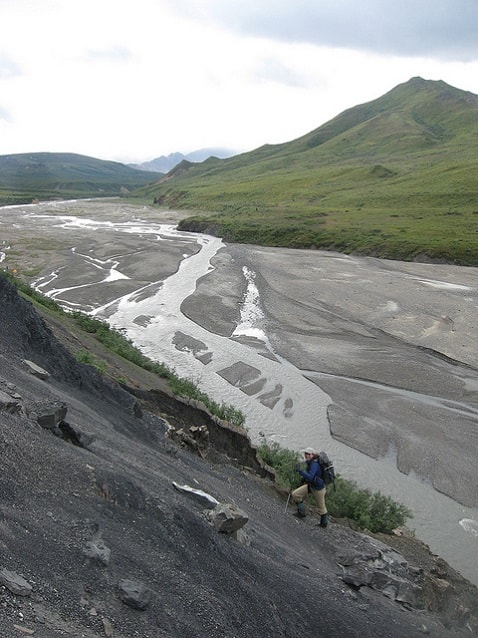 Thanks to Som sai for this link of interest.. I do think that environmental justice or even plain old social justice has been somewhat overlooked with regard to many issues. We need to think about it with regard to all the issues we face. It seems to me that it’s like so many things in our world… there’s an abstraction.. biodiversity, climate change, environmental justice, social justice; but for some reason our thinking about them gets channelized (a thinking ditch) when if we arrayed all the choices, they would be more like a braided stream, multi-threaded and dynamic.
Thanks to Som sai for this link of interest.. I do think that environmental justice or even plain old social justice has been somewhat overlooked with regard to many issues. We need to think about it with regard to all the issues we face. It seems to me that it’s like so many things in our world… there’s an abstraction.. biodiversity, climate change, environmental justice, social justice; but for some reason our thinking about them gets channelized (a thinking ditch) when if we arrayed all the choices, they would be more like a braided stream, multi-threaded and dynamic.
What unique challenges do large carnivore reintroductions pose that environmental justice can help address?
Large carnivores are a unique set of species for a lot of different reasons. They are involved in just about every kind of human-animal conflict you can imagine, so we thought they were a challenging but important place to start. Some of these challenges: People who make decisions about carnivore reintroductions sometimes don’t live near the places where the recovery efforts — and potential related animal-human conflicts — are occurring. Large carnivores themselves are wide-ranging and highly mobile. One animal’s erratic behavior can impact people’s view of the entire species. So, the challenges and the opportunities go hand in hand, and that makes this difficult, but also important, to tackle.
In the paper, you describe four components of environmental justice that are important to consider in conservation projects. Can you explain those in the context of large carnivore reintroductions?
- Distribution considers who is actually being harmed materially and who is benefiting
- Participation asks who has a seat at the decision-making table
- Recognition asks whose worldview is being recognized in the terms of the debate or in the discussion itself
- And finally, affective (or emotional) justice considers how we appropriately account for people’s emotions — fear, anger, happiness, for example — toward the reintroduction of certain species
On this last point: On one hand, we should take emotions really seriously — fear can be life-changing and is very important to understand as a harm in and of itself. And at the same time, emotions can be difficult to estimate, and they can reorient power dynamics. In the case of large carnivores, we’ve often seen people who are not vulnerable or marginalized use emotions like fear to make themselves into victims. They wind up having an even bigger voice in the decision-making process than they might have had before.
So how can we use this environmental justice framework going forward in these reintroduction efforts?
Through a justice lens, we can ask questions about who is making decisions, and whether they are people who are in power, or people who are already marginalized. We can try to measure the ways in which material harm has been inflicted on different groups of people, or the ways in which impacts are unequally distributed. Social science, or humanistic, considerations tell us a bit about the bigger picture: What are the worldviews involved, how might those limit or enable discussions that weren’t possible before, and how are people’s emotional experiences shaping these conversations and the possible outcomes?
The reintroduction of wolves to Yellowstone National Park happened in 1995 and has been hugely divisive ever since. People have spent millions of dollars trying to address the problems that arose. But, in fact, it might be that a different kind of framing — one around justice — could offer an important new step toward addressing these problems.
This isn’t something folks love to hear, but I think the truth is, if you expect a framework like this to give you a single, perfect answer to solve problems, you’re setting yourself up for failure. Large carnivore reintroductions include a complicated and challenging set of circumstances, so having a process in place is really important, especially one that’s informed by a good understanding of justice.
What’s next with this work?
Our goal is to walk through this framework using a possible California grizzly bear reintroduction as a case study to lay out what it would actually look like to do this while thinking about environmental justice from the very beginning.
Another option would be to study the Colorado reintroduction of wolves. Certainly it started not very well from an ej (environmental justice) .. decision made by a state-wide initiative vote and won by Coloradans who don’t live in the country of reintroduction. Arguably it would be interesting to begin to consider ej at this point.
